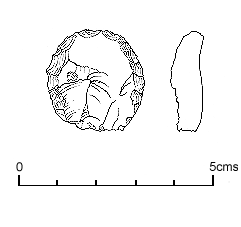
Discoid scraper (Sf652)
The majority of the flint recovered from the excavation is unworked material of a very inhomogeneous nature. Most of the worked fragments are flakes, varying in size from small chips to medium sized flakes up to 55mm long. Two blades were identified, both from post-medieval or later contexts (sfs415 and 630).
Four cores were recovered, three of them from Roman layers (sfs402, 403 and 549), and one from the topsoil (sf391). These showed a range of utilization from one to many striking platforms, and were relatively small in size.
A small number of flakes had been further utilized as scrapers. Four of these were recovered from post-medieval or later contexts (sfs570, 632, 558 and 633). The latter two are similar, being of the same red-brown flint and made to a similar pattern. There is one very fine example of a discoid scraper, which has been finely retouched over the entire ventral surface to provide an almost continuous cutting edge (sf652). This was recovered from a 2nd century ditch.

Discoid scraper (Sf652)
In addition, three flakes which had been retouched to provide a short cutting edge were found in Roman contexts (sfs580, 641 and 643).
The range of types, colours and patinas indicates that this material is largely residual and of limited value. It does, however, suggest that the Romans may have used flint, as indicated by the material from Blake Street, York (Cool et al. 1995).
© Internet Archaeology
URL: http://intarch.ac.uk/journal/issue9/brough/flint.html
Last updated: Tue Nov 28 2000